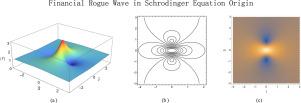Going beyond the Black–Scholes option pricing model: Financial rogue waves in quantum mechanics
IF 4.6
2区 物理与天体物理
Q1 PHYSICS, MULTIDISCIPLINARY
引用次数: 0
Abstract
This paper proposes a nonlinear alternative for the Black–Scholes option pricing model defined as the Schrödinger equation. The Black–Scholes equation is obtained from the Schrödinger equation in the leading-order approximation of an asymptotic perturbation theory under the assumptions of weak nonlinearity and weak dispersion. It models the controlled Brownian motion of the financial market and describes the option price wave function in quantum mechanic origin. Here, we analytically predict the existence of a family of financial rogue wave solutions of the Black–Scholes equation in the form of complex rational functions by using symbolic computation. The obtained solutions are composed of a single symmetric soliton or several solitary peaks. The existence of non-zero offset parameters provides nontrivial alterations to higher order solutions as they would decompose into first order ones that can be used to simulate the evolution of financial risks. The financial rogue wave solution demonstrates a condition that investors may face considerable risk or return in the financial market, which might be an actual theoretical basis for its existence. Our study is the first to prove the connection between option pricing and quantum mechanics, which opens a novel path for the excitation and control of financial waveforms of quantum mechanic footprint and extreme financial crisis. Currently, there are no similar studies, making this work crucial and significant for the advancement of quantum finance.

超越布莱克-斯科尔斯期权定价模型:量子力学中的金融流氓波
本文提出了Black-Scholes期权定价模型的非线性替代方案,定义为Schrödinger方程。在弱非线性和弱色散的假设下,由渐近摄动理论的阶近似Schrödinger方程得到了Black-Scholes方程。建立了金融市场受控布朗运动模型,从量子力学的角度描述了期权价格波动函数。本文采用符号计算的方法,以复有理函数的形式分析预测了Black-Scholes方程的一类金融流氓波解的存在性。得到的解由一个对称孤子或几个孤峰组成。非零偏移参数的存在为高阶解提供了重要的改变,因为它们将分解为可用于模拟金融风险演变的一阶解。金融流氓波解证明了投资者在金融市场中可能面临相当大的风险或回报,这可能是其存在的实际理论基础。我们的研究首次证明了期权定价与量子力学之间的联系,为量子力学足迹与极端金融危机的金融波形激励与控制开辟了一条新的路径。目前还没有类似的研究,因此这项工作对于量子金融的发展至关重要。
本文章由计算机程序翻译,如有差异,请以英文原文为准。
求助全文
约1分钟内获得全文
求助全文
来源期刊

Chinese Journal of Physics
物理-物理:综合
CiteScore
8.50
自引率
10.00%
发文量
361
审稿时长
44 days
期刊介绍:
The Chinese Journal of Physics publishes important advances in various branches in physics, including statistical and biophysical physics, condensed matter physics, atomic/molecular physics, optics, particle physics and nuclear physics.
The editors welcome manuscripts on:
-General Physics: Statistical and Quantum Mechanics, etc.-
Gravitation and Astrophysics-
Elementary Particles and Fields-
Nuclear Physics-
Atomic, Molecular, and Optical Physics-
Quantum Information and Quantum Computation-
Fluid Dynamics, Nonlinear Dynamics, Chaos, and Complex Networks-
Plasma and Beam Physics-
Condensed Matter: Structure, etc.-
Condensed Matter: Electronic Properties, etc.-
Polymer, Soft Matter, Biological, and Interdisciplinary Physics.
CJP publishes regular research papers, feature articles and review papers.
 求助内容:
求助内容: 应助结果提醒方式:
应助结果提醒方式:


